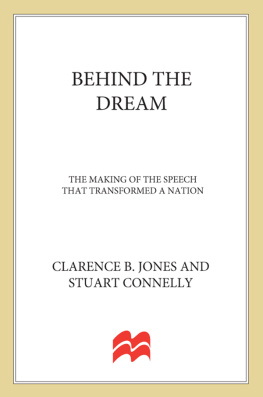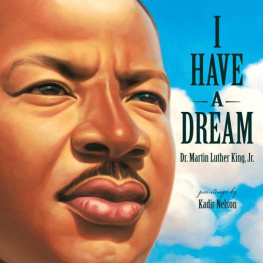I n 1963, the year that Martin Luther King, Jr., delivered one of the most famous speeches in American history, blacks in America lived under a racial caste system. Twelve million of the nations nineteen million black citizens lived in the South, where Jim Crow segregation pervaded nearly every aspect of life. Southern towns maintained separate hotels, beaches, bathrooms, restaurants, and drinking fountains for whites and blacks. Nearly a decade after the Supreme Courts decision in Brown v. Board of Education, school desegregation was at a standstill. Fewer than one-half of 1 percent of black children in the South attended public schools with white children. Many Southern states operated completely segregated school systems, in open defiance of Brown . Not a single black child in South Carolina, Alabama, or Mississippi attended an integrated public school during the 196263 school year.
Many counties in the South barred blacks from voting. A 1963 survey by the United States Commission on Civil Rights found that, in one hundred of the Souths counties with the highest proportions of black residents, only 8.3 percent of blacks were registered to vote. White voter registrars applied a racial double standard to applications, rejecting black applicants because of minor errors in their applications, while indiscriminately registering white applicants, including one who, in response to a question about a section of the Louisiana Constitution, wrote, FRDUM FOOF SPETGH. Registrars would sometimes shut down the registration offices when black applicants arrived. In Madison Parish, Louisiana, where blacks of voting age outnumbered whites of voting age by nearly two to one, the electoral rolls held ten times as many white voters as black voters. In Wilcox County, Alabama, none of the 6,085 blacks of voting age were registered to vote. Chief Judge Elbert Tuttle of the Fifth Circuit Court of Appeals began an opinion about voting rights in Panola County, Mississippi, with:
When this suit was filed by the United States on October 16, 1961, Panola County, Mississippi, had 7,639 white persons, and 7,250 Negroes of voting age. At least 5,343 white persons were then registered to vote. The only Negro registered to vote in Panola County was R.H. Hightower, 92 years old, who had registered in 1892. This does not tell the whole story, because another Negro, E.H. Holloway, was registered on January 5, 1952, but he is now deceased.
Many Southern blacks could not serve on juries. The Supreme Court had struck down statutes that barred blacks from jury service in Strauder v. West Virginia, a case decided in 1879, but some Southern counties maintained all-white juries through the early 1960s. White officials responsible for composing jury lists picked jurors based on personal acquaintance, guaranteeing that no blacks would be selected. In Mitchell County, Georgia, jury lists were drawn from color-coded tax returns (yellow for blacks, white for whites), and, as of 1963, none of the countys 9,000 blacks had ever served on a jury.
White Southerners maintained segregation not just by enforcing the Jim Crow laws, but by committing retaliatory acts of violence against blacks who challenged the regions racial caste system. In the summer of 1955, Emmett Till, a fourteen-year-old boy from Chicago, was murdered by two white men after he had allegedly whistled at a white woman in a Mississippi store. His body was found in the Tallahatchie River, with an iron gin-mill fan tied with wire around his neck and a bullet in his head. The Emmett Till murder attracted nationwide media attention, but thousands of similar crimes went unnoticed outside the South. According to the Tuskegee Institute, 3,444 blacks were lynched between 1882 and 1963. Even this figure understates the violence against black Americans under Jim Crow, because it only counts public summary executions by white mobs. Whites frequently perpetrated less public beatings and murders against blacks who tried to exercise constitutionally protected rights. Three months before Emmett Till arrived in Mississippi, the Reverend George Lee, the first black man to register to vote in Belzoni, Mississippi, was shot. One week before Emmett Till arrived in Mississippi, Lamar Smith, a black farmer who had been warned to quit trying to get Negroes to vote, was shot in the middle of the day in front of a courthouse. No arrests were made in either case.
In the North, there were no Whites Only signs, but segregation was no less a reality than in the South. Almost every Northern city was sharply segregated into white and black neighborhoods. The Supreme Court had invalidated racially restrictive covenants in its 1948 decision in Shelley v. Kraemer, but blacks were effectively kept out of white neighborhoods by a variety of less obvious devices. White realtors entered into voluntary agreements with one another not to sell to black clients. White bankers practiced redlining, refusing to lend money to homeowners in black areas. Governments demolished black neighborhoods they deemed slums and displaced residents into public housing projects. Black families who tried to move to all-white neighborhoods in Northern cities were often harassed or attacked by white mobs.
Black Americans were almost totally absent from many sectors of the nations economy. Blacks owned 2.6 percent of all retail outlets and less than 0.2 percent of all banks or financing institutions. The median income of black men was half that of white men. The median income of black women was two-thirds that of white women. White men had a higher median income in 1948 than black men did in 1963. Black unemployment was twice the white rate; black arrests were five times the white rate.
Black actors were rarely seen in movies, except in roles that Sidney Poitier characterized as other-cheek-turners. Jackie Robinson had started the integration of baseball, but there were few blacks in golf, tennis, or basketball. There were no blacks in the presidents cabinet, no blacks on the Federal Reserve Board, no black members of the New York Stock Exchange, and no black mayors in any city of the United States. Some white academics scorned black culture and history: In 1963, Nathan Glazer and Daniel Moynihan wrote: [T]he Negro is only an American, and nothing else. He has no values and culture to guard and protect.
By 1963, thousands of black Americans had participated in the protests against Jim Crow that would come to be known as the civil rights movement. The modern civil rights movement is conventionally thought to have started on December, 5, 1955, the first day of a boycott of the segregated city buses in Montgomery, Alabama. The black women of Montgomery had called the boycott after the arrest of Rosa Parks, an active member of the local chapter of the National Association for the Advancement of Colored People (NAACP), for refusing to stand over a row of empty seats so that a white man could sit in the same row. On the afternoon of the boycotts first day, the black ministers of Montgomery met to set up an organization to support the womens protest. Montgomery is known as the birthplace of the modern civil rights movement because of a decision made at that meeting. When it was time to choose officers, the ministers nominated the Reverend Martin Luther King, Jr., the twenty-six-year-old pastor of the Dexter Avenue Baptist Church, to be president of the new organization.
King was not an obvious choice to lead the Montgomery bus boycott. He had lived in Montgomery for just over a year. His strongest credentials were academic: He had attended college at Morehouse, seminary at Crozer in Pennsylvania, and received a Ph.D. from Boston University. He had not been known as a civil rights activist in college or graduate school. One of the few foreshadowings of his later career was what one of his professors recalled as his vivid memories of Kings interest in the prophets of the Hebrew Bible. In an essay on the prophet Jeremiah, King wrote:











